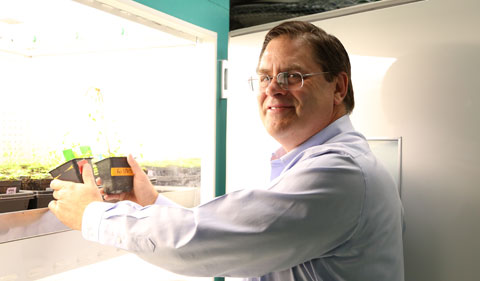
Dr. Allan Showalter’s lab is studying Arabidopsis thaliana, a plant commonly used as a model organism for genetic studies.
By Amanda Biederman
NQPI editorial intern
Ohio University Environmental & Plant Biology professor and Nanoscale & Quantum Phenomena Institute member Allan Showalter is investigating the interplay between five plant genes in Arabidopsis thaliana that may contribute to saline tolerance. The genes GALT2, GALT5, SOS5, FEI1 and FEI2 encode proteins that perform distinct biochemical functions.
The knockout of any one of the genes results in a common phenotype: roots that swell in the presence of salt. The effect is unchanged when the expression of all five genes is hindered. Showalter said he believes the kinases encoded by FEI1 and FEI2 may contribute to a signaling pathway that involves GALT2, GALT5 and SOS5. GALT2 and GALT5 encode enzymes that transfer sugars onto a cell wall protein encoded by SOS5.
“If you see the same (phenotype) in a multiple knockout mutant, then that implies those genes are in the same pathway,” Showalter said. “If they were in two different pathways, you might expect the root to swell even more. But that wasn’t the case.”
Molecules in a linear pathway are interdependent, meaning that the knockout of any associated gene would halt the process entirely. If the knockout of any of the genes—or several genes at once—results in a common phenotype, the encoded proteins may function together.
Showalter’s group is working to provide evidence for a biochemical connection between the proteins encoded by these genes by performing an enzyme-linked immunosorbent assay (ELISA). In essence, a kinase (encoded by FEI1 or FEI2) is made to adhere to a plastic well. The sugar-linked adhesion protein (encoded by SOS5) is added and washed. The group can then test for a tag sequence on the sugar-linked protein. If the tag is present after washing, Showalter said he will know the molecules share a common pathway and physically interact with one another.
He said a better understanding of physiological responses to salt may allow for the development of genetically engineered crops that can tolerate high-salt environments such as those in certain parts of the Middle East and in other parts of the world.
“People are thinking about … how all these components of a salt-sensing, salt-transduction system are working,” Showalter said. “But you have to understand how this pathway works in order to manipulate it.”



















Comments